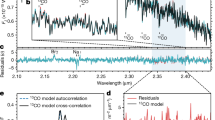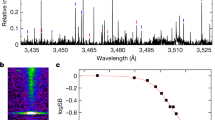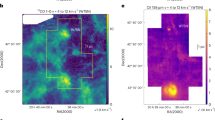Abstract
Nitrogen is the fifth most abundant element in the Universe. In the interstellar medium, it has been thought to be mostly molecular (N2)1. However, N2 has no observable rotational or vibrational transitions, so its abundance in the interstellar medium remains poorly known. In comets, the N2 abundance is very low2,3, while the elemental nitrogen abundance is deficient with respect to the solar value. Moreover, large nitrogen isotopic anomalies are observed in meteorites and interstellar dust particles4. Here we report the N2H+ (and by inference the N2) abundance inside a cold dark molecular cloud. We find that only a small fraction of nitrogen in the gas phase is molecular, with most of it being atomic. Because the compositions of comets probably reflect those of dark clouds5, this result explains the low N2 abundance in comets. We argue that the elemental nitrogen abundance deficiency in comets can be understood if the atomic oxygen abundance is lower than predicted by present chemical models. Furthermore, the lack of molecular nitrogen in molecular clouds explains the nitrogen anomalies in meteorites and interstellar dust particles, as nitrogen fractionation is enhanced if gaseous nitrogen is atomic6.
This is a preview of subscription content, access via your institution
Access options
Subscribe to this journal
Receive 51 print issues and online access
$199.00 per year
only $3.90 per issue
Buy this article
- Purchase on Springer Link
- Instant access to full article PDF
Prices may be subject to local taxes which are calculated during checkout



Similar content being viewed by others
References
Herbst, E. & Klemperer, W. The formation and depletion of molecules in dense interstellar clouds. Astrophys. J. 185, 505–534 (1973)
Cochran, A. L., Cochran, W. D. & Barker, E. S. N2+ and CO+ in Comets 122P/1995 S1 (deVico) and C/1995 O1 (Hale-Bopp). Icarus 146, 583–593 (2000)
Iro, N., Gautier, D., Hersant, F., Bockelée-Morvan, D. & Lunine, J. I. An interpretation of the nitrogen deficiency in comets. Icarus 161, 511–532 (2003)
Messenger, S., Keller, L. P., Thomas, K. L. & Walker, R. M. Nitrogen petrography in two 15N-rich IDPs. Meteorit. Planet. Sci. 31, A88 (1996)
Irvine, W. M., Schloerb, F. P., Crovisier, J., Fegley, B. & Mumma, M. J. Comets: a link between interstellar and nebular chemistry. Protostars Planets IV, 1159–1200 (2000)
Charnley, S. B. & Rodgers, S. D. The end of interstellar chemistry as the origin of nitrogen in comets and meteorites. Astrophys. J. Lett. 569, L133–L137 (2002)
Linke, R. A., Langer, W. D. & Guelin, M. Detection of H15NN+ and HN15N+ in interstellar clouds. Astrophys. J. Lett. 271, L85–L88 (1983)
Tafalla, M., Myers, P. C., Caselli, P., Walmsley, C. M. & Comito, C. Systematic molecular differentiation in starless cores. Astrophys. J. 569, 815–835 (2002)
Bergin, E. A., Alves, J., Huard, T. & Lada, C. J. N2H+ and C18O depletion in a cold dark cloud. Astrophys. J. Lett. 570, L101–L104 (2002)
Pagani, L., Pardo, J.-R., Apponi, A. J., Bacmann, A. & Cabrit, S. L183 (L134N) revisited. III. The gas depletion. Astron. Astrophys. 429, 181–192 (2005)
Öberg, K. I. et al. Competition between CO and N2 desorption from interstellar ices. Astrophys. J. Lett. 621, L33–L36 (2005)
Geppert, W. D. et al. Dissociative recombination of N2H+: Evidence for fracture of the NN bond. Astrophys. J. 609, 459–464 (2004)
Bergin, E. A., Langer, W. D. & Goldsmith, P. F. Gas-phase chemistry in dense interstellar clouds including grain surface molecular depletion and desorption. Astrophys. J. 441, 222–243 (1995)
Alves, J. F., Lada, C. J. & Lada, E. A. Internal structure of a cold dark molecular cloud inferred from the extinction of background starlight. Nature 409, 159–161 (2001)
Bergin, E. A. et al. The thermal structure of gas in pre-stellar cores: a case study of Barnard 68. Astrophys. J. (in the press)
Caselli, P., Walmsley, C. M., Terzieva, R. & Herbst, E. The ionization fraction in dense cloud cores. Astrophys. J. 499, 234–249 (1998)
Caselli, P. et al. Molecular ions in L1544. II. The ionization degree. Astrophys. J. 565, 344–358 (2002)
Womack, M., Ziurys, L. M. & Wyckoff, S. Estimates of N2 abundances in dense molecular clouds. Astrophys. J. 393, 188–192 (1992)
Bockelée-Morvan, D. et al. New molecules found in comet C/1995 O1 (Hale-Bopp). Investigating the link between cometary and interstellar material. Astron. Astrophys. 353, 1101–1114 (2000)
Wyckoff, S., Tegler, S. C. & Engel, L. Nitrogen abundance in comet Halley. Astrophys. J. 367, 641–648 (1991)
Gibb, E. L., Whittet, D. C. B., Boogert, A. C. A. & Tielens, A. G. G. M. Interstellar ice: the Infrared Space Observatory legacy. Astrophys. J. Suppl. 151, 35–73 (2004)
Terzieva, R. & Herbst, E. The possibility of nitrogen isotopic fractionation in interstellar clouds. Mon. Not. R. Astron. Soc. 317, 563–568 (2000)
Knauth, D. C., Andersson, B.-G., McCandliss, S. R. & Warren Moos, H. The interstellar N2 abundance towards HD 124314 from far-ultraviolet observations. Nature 429, 636–638 (2004)
Caselli, P., Myers, P. C. & Thaddeus, P. Radio-astronomical spectroscopy of the hyperfine structure of N2H+. Astrophys. J. Lett. 455, L77–L80 (1995)
Keto, E., Rybicki, G. B., Bergin, E. A. & Plume, R. Radiative transfer and starless cores. Astrophys. J. 613, 355–373 (2004)
Acknowledgements
This work is supported by the National Science Foundation. S.M. is grateful to E. Herbst for discussions about the N2 formation reaction rates. S.M. also thanks E. Keto for discussions about the radiative transfer of N2H+ hyperfine structure lines. Author contributions S.M. and E.A.B. performed the chemical and radiative transfer modelling presented in this paper. S.M. wrote the paper. All authors discussed the results and commented on the manuscript.
Author information
Authors and Affiliations
Corresponding author
Ethics declarations
Competing interests
Reprints and permissions information is available at npg.nature.com/reprintsandpermissions. The authors declare that they have no competing financial interests.
Supplementary information
Supplementary Discussion
This discussion presents the chemical modeling performed in the paper into more details. It explains the time dependence of this model. It also describes the chains of reactions that lead to the formation of molecular nitrogen in the gas phase, and explain how a low oxygen abundance (with respect to current model predictions) could explain the elemental nitrogen deficiency observed in comets. Finally, the results of the present paper are compared with earlier studies. (PDF 29 kb)
Rights and permissions
About this article
Cite this article
Maret, S., Bergin, E. & Lada, C. A low fraction of nitrogen in molecular form in a dark cloud. Nature 442, 425–427 (2006). https://doi.org/10.1038/nature04919
Received:
Accepted:
Issue Date:
DOI: https://doi.org/10.1038/nature04919
This article is cited by
-
Reactive ammonia in the solar protoplanetary disk and the origin of Earth’s nitrogen
Nature Geoscience (2015)
-
Chemistry in low-mass star forming regions
Astrophysics and Space Science (2008)
Comments
By submitting a comment you agree to abide by our Terms and Community Guidelines. If you find something abusive or that does not comply with our terms or guidelines please flag it as inappropriate.



